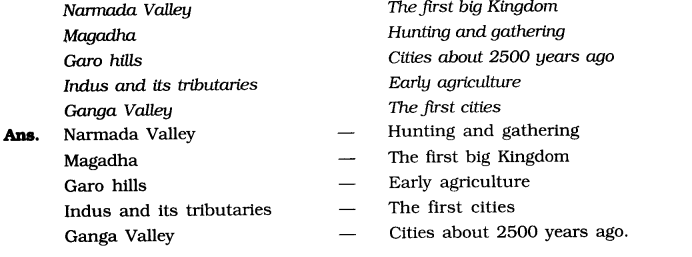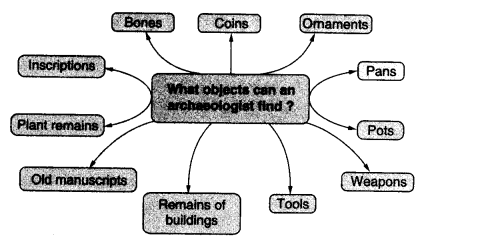HISTORY CLASS 6TH(What, Where, How and When?)
- Get link
- X
- Other Apps
NCERT Solutions for Class 6, 7, 8, 9, 10, 11 and 12
NCERT Solutions for Class 6 Social Science History Chapter 1 What, Where, How and When?
by phani
NCERT Solutions for Class 6 Social Science History Chapter 1 What, Where, How and When?
1. Match the following:
2. List one major difference between manuscripts and inscriptions.
Answer:
3. Return to Rasheeda’s question. Can you think of some answers to it?
Answer: One can know what had happened so many years ago through these ways:
4. Make a list of as. the objects that archaeologists may find. Which of these could be made of stone?
Answer: The answer can be summarized through this flow diagram:
The ones that could be made of stone are
- Surface used for writing inscriptions
- Remains of buildings
- Objects like tools, weapons, etc.
5. Why do you think ordinary men and women did not generally keep records of what they did?
Answer:
We think ordinary men and women did not generally keep records of what they did due to the following reasons:
- They did not know the art of writing in the beginning.
- Even some of them were not literate even after the knowledge of the script.
- They were not having an interest in such works.
- They did not know the importance of keeping records of the events. The lack of historical sense was mainly responsible for it.
6. Describe at least two ways in which you think the lives of kings would have been different from those of farmers.
Answer:
- The kings used to live in palaces or big houses. The farmers used to live in huts or in very small houses.
- The kings were dependent for their food on farmers. Farmers used to produce food for themselves and other people also.
- The kings wore showy and costly clothes and ornaments. Farmers wore simple and very cheap clothes. (Any two)
7. Find the word ‘crafts persons’ on-page of the textbook. In the list at least five different crafts that you know about today. Are the craftspersons—(a) men (b) women (c) both men and women
Answer: The various crafts that dominate the present life are listed here:
These craftspersons are both men and women.
8. What were the subjects on which books were written in the past? Which of these would you like to read?
Answers:
Before paper was discovered scholars wrote on:
- dried leaves,
- on the bark of birch trees and
- sometimes on copper (or metal) plates and stones.
We would like to read Vedas, Ramayana, Mahabharata and Panchtantra.
I. Multiple Choice Questions
Choose the correct option to complete the statements given below:
(i) People who gathered their food are called……………….
(a) hunters
(b) skilled gatherers
(c) farmers
(d) merchants.
(ii) The places where rice was first grown are located in ………………
(a) north of the Vindhyas
(b) Sulaiman hills
(c) on the banks of the Ganga
(d) the Gaxo hills.
(iii) …… was not used in the old books.
(a) Prakrit
(b) Hindi
(c) Sanskrit
(d) Tamil
(iv) The kingdom of Magadha was located ……………
(a) on the banks of the Indus
(b) in the south of the Vindhyas
(c) in the area along Ganga’s tributaries in the south of Ganga.
(d) in the Garo hills region.
Answers:
(i)—(b), (ii)—(a), (iii)—(b), (iv)—(c).
II. Fill in the Blanks
Fill in the blanks with appropriate words to complete each sentence:
- Men and women moved in search of……………… and to escape from …………..
- The name India was given by the Iranians and the ………………
- The bark of the birch tree was used to prepare………………
- Inscriptions were written on hard surfaces like………………
- Travelling from one place to another led to ……………..
Answers:
- livelihood, natural disasters
- Greeks
- manuscripts
- (stone/metal
- sharing of ideas.
III. True/False
State whether these sentences are true (Tj or false (F).
- The first crops were grown almost 8000 years ago.
- The Garo hills are located in the south of India.
- The Magadha Kingdom was set up near the Ganga river.
- The Rigveda is the earliest composition in the Sanskrit language.
- The Iranians and the Greeks called India Bharat.
- Inscriptions were written on the palm leaf.
- The years are counted with reference to the birth of Christ.
- Ordinary people used Prakrit to talk to each other.
Answers:
- True
- False
- True
- True
- False
- False
- True
- True
IV. Matching Skill
Match the items in column A correctly with those given in column B.
NCERT Solutions For Class 6 History Chapter 1 Very Short Answer Type Questions
1. What do you know about the location of the Sulaiman and Kirthar hills?
Or
Where are the Sulaiman and Kirthar hills located?
Answer: The Sulaiman and Kirthar hills are located In the modem day Pakistan.
2. Name any two animals which the people of the Sulaiman and Kirthar hills reared.
Answer: Sheep and goat.
3. Where are the Garo hills located?
Answer: The Garo hills are in the north-east of India.
4. What are tributaries? [V. Imp.]
Answer: Tributaries are smaller rivers that flow into a bigger river.
5. Name the tributary of the river Ganga.
Answer: Son.
6. Where was Magadha located?
Answer: Magadha was located in the south of the Ganga.
7. Why was Magadha famous? [V. Imp.]
Answer: Magadha was famous because its mlers were very powerful who established a big kingdom.
8. What was the job of religious teachers? [V. Imp.]
Answer: Religious teachers moved from one place to another to offer instruction and advice to the people who met on the way.
9. From where does the word India come?
Answer: The word India comes from the Indus, known as Sindhu in Sanskrit.
10. What is meant by the manuscript?
Answer: Manuscript is a hand-written matter.
11. What was used in ancient times to write manuscripts?
Answer: Palm leaf or the bark of the birch tree was used in ancient times to write manuscripts.
12. What are inscriptions?
Answer: Inscriptions are writings on relatively hard surfaces like stone or metal.
13. Why do archaeologists look for bones of animals, birds, and fish?
Answer: They do so in order to find out what people ate in the past.
14. What are the occupations of the people of the Andaman Islands?
Answer: The people of the Andaman Islands are engaged in fishing, hunting, and collecting forest produce.
What Where How and When Class 6 History Chapter 1 Short Answer Type Questions
1. What do you know about the earliest people who lived along the banks of river Narmada for several hundred thousand years?
Answer: Those people were skilled gatherers. They gathered their food. They also collected roots, fruits and other forest produce for their food. They also hunted animals for this purpose.
2. People in the earliest times used to travel from one place to another. But their journeys were full of dangers. What type of dangers did they face?
Answer: It is true that people in the earliest times used to travel from this place to that. But their journeys were dangerous. The hills, and high mountains including the Himalayas, deserts, rivers and seas created dangers for them. But they never got afraid of them. Instead they overcame them and continued to travel.
3. Who are archaeologist? What do they do? [V. Imp.]
Answer: Archaeologists are persons who study the objects of the past. They study the remains of the buildings made of stone and brick, paintings and sculpture. They also explore and dig the earth in order to find out tools, weapons, pots, pans, ornaments and coins.
4. How are city people different from the people living in the Andaman Islands?
Answer: People living in the Andaman Islands manage their own food by fishing, hunting and collecting forest produce. On the other hand city, people depend on others for supplies of food.
5. How can you say that historians and archaeologists are like detectives? [V. Imp.]
Answer: Historians often use the word source to refer to the information found from manuscripts, inscriptions and archaeology. Once sources are found, learning about the past becomes an adventure, as we reconstruct it bit by bit. So, historians and archaeologists are like detectives who use all these sources like clues to discover the past.
NCERT History Class 6 Chapter 1 Long Answer Type Questions
1. How was traveling an important part of the life of the people in the past? [V. Imp.]
Answer:
People in the past were very fond of travelling from one place to another. Although the hills and high mountains like the Himalayas, deserts, rivers, and seas posed great problems, people kept on travelling. They moved in search of livelihood. They had also in their mind to escape from natural disasters such as floods and droughts. Sometimes, men marched in armies and conquered others’ lands.
Merchants travelled with caravans or ships. They carried valuable goods from place to place. There were religious teachers who used to walk from village to village, town to town. They offered instruction and advice to the people who met them on the way. There were also people who travelled because they were adventurous by nature. They enjoyed discovering new and exciting places.
2. What are the different ways to find out about the past? Describe briefly. [Imp.]
Answer:
The different ways to find out about the past are the following:
(i) Manuscripts. These were the hand-written matters. They were usually written on palm leaf or the bark of the birch tree. While many of these manuscripts got destroyed, many have survived in temples and monasteries. These books dealt with all kinds of subjects such as religious beliefs and practices, the lives of kings, medicines, and science. These manuscripts also included epics, poems, plays.
(ii) Inscriptions are writings on relatively hard surfaces such as stone or metal. Sometimes, kings got their orders inscribed in order to make common people aware of them. Some inscriptions kept records of victories in battle.
(iii) Archaeological excavations or evidence. Archaeology means the study of cultures of the past and of periods of history by examining the remains of buildings and objects found in the earth. Archaeologists explore and dig earth to find tools, weapons, pots, pans, ornaments, and coins. These things provide us valuable information about the past.
NCERT Solutions for Class 6 Social Science History
- Chapter 1 What, Where, How and When?
- Chapter 2 On The Trial of the Earliest People
- Chapter 3 From Gathering to Growing Food
- Chapter 4 In the Earliest Cities
- Chapter 5 What Books and Burials Tell Us
- Chapter 6 Kingdoms, Kings and an Early Republic
- Chapter 7 New Questions and Ideas
- Chapter 8 Ashoka, The Emperor Who Gave Up War
- Chapter 9 Vital Villages, Thriving Towns
- Chapter 10 Traders, Kings and Pilgrims
- Chapter 11 New Empires and Kingdoms
- Chapter 12 Buildings, Paintings, and Books
QUICK RESOURCES
- Get link
- X
- Other Apps
Comments
Post a Comment